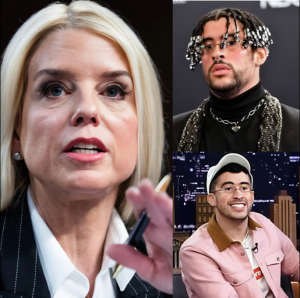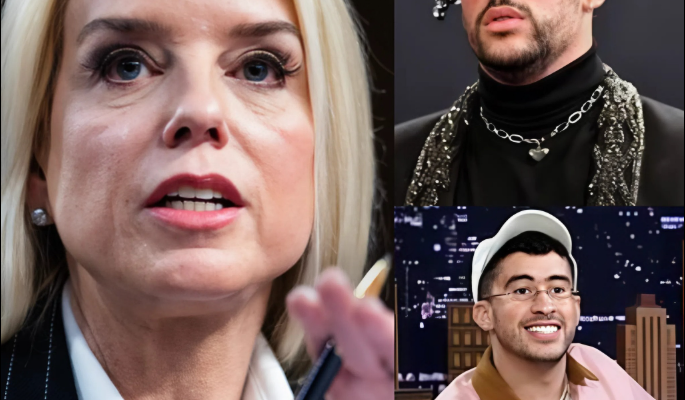The story of Pam Bondi allegedly demanding that the National Football League cancel Bad Bunny’s upcoming Super Bowl halftime show and then dropping a so-called bombshell that lit up social media has become a flashpoint in the swirling intersection of politics, celebrity culture, and online rumor. To understand the context fully, it is important to separate what is verifiable from what appears to be pure speculation. This requires examining the origins of the claim, the actual circumstances around Bad Bunny’s halftime performance, and the environment in which such dramatic stories take root and spread.
First, let us consider what is actually true and confirmed. Bad Bunny, the Puerto Rican megastar whose global rise has redefined Latin music’s influence in mainstream American pop culture, has indeed been announced as the headliner for the 2026 Super Bowl halftime show. This news was confirmed by the NFL in cooperation with Apple Music and Roc Nation, the production company long associated with curating halftime talent. The event will take place at Levi’s Stadium in Santa Clara, California. The announcement sparked excitement among his millions of fans across Latin America, the Caribbean, the United States, and beyond. Bad Bunny himself issued a statement dedicating the performance to his culture, his language, and his community, framing the show as a celebration of heritage and global artistry.
With such visibility comes backlash, and criticism has not been slow to surface. Prominent conservative figures and media commentators have openly voiced displeasure with the NFL’s choice. Some argue that the halftime stage should be reserved for more “traditional” American entertainers, while others frame their objection around language, complaining that Bad Bunny frequently performs in Spanish. Still others attack him for political reasons, linking his identity and outspoken activism to broader cultural shifts they see as threatening. Figures such as Texas Attorney General Ken Paxton have already made comments expressing dissatisfaction with the league’s direction, portraying the selection as another example of “politicized entertainment.”
This environment of cultural polarization provides fertile ground for rumors. Enter the claim involving Pam Bondi, the former Attorney General of Florida and a prominent conservative media figure. According to circulating posts on Facebook, LinkedIn, and other social channels, Bondi supposedly erupted on live television demanding that the NFL cancel Bad Bunny’s halftime show immediately. The rumor goes further, suggesting that she then revealed a bombshell that shocked audiences and sent waves across social platforms. These claims are presented in the dramatic style of viral clickbait: “SHOCKING,” “ERUPTS,” and “BOMBSHELL.” They spread rapidly, shared by users who may not pause to check whether mainstream or reliable outlets have confirmed the story.
However, there is a striking absence of credible evidence. Searches across major news databases yield no coverage of Bondi making such remarks. There are no video clips, no transcripts, and no statements from Bondi herself available in reputable publications. Outlets such as Reuters, the Associated Press, the New York Times, and even partisan cable networks that regularly feature Bondi have not carried anything resembling this claim. The only instances appear on pages designed to maximize engagement through sensational headlines. In short, there is no verifiable record of Pam Bondi ever demanding the NFL cancel Bad Bunny’s show, nor is there any evidence of her unveiling a supposed bombshell in connection to this story.
Why, then, does such a rumor spread so easily? Part of the answer lies in the dynamics of cultural conflict. The Super Bowl halftime show has, for years, been more than just entertainment. It has become a symbolic stage where issues of race, identity, patriotism, and political alignment play out in front of one of the largest audiences in the world. Past performances by Beyoncé, Jennifer Lopez, Shakira, The Weeknd, and Rihanna have all sparked heated debates, with critics accusing the NFL of pandering to certain demographics or promoting divisive messages. Against this backdrop, the selection of Bad Bunny, a Spanish-speaking Puerto Rican artist with outspoken political stances, becomes the perfect flashpoint for cultural warriors on both sides. A fabricated claim about Bondi fits neatly into this narrative, giving conservative critics a figurehead who supposedly speaks their frustrations loudly.
Another factor is Bondi herself. As a recognizable conservative personality, she is a plausible name to attach to such a statement. Her past as Florida Attorney General, her alignment with former President Donald Trump, and her frequent television appearances all make her a convenient stand-in for the voice of conservative outrage. Even if she never said a word about Bad Bunny, attributing the demand to her makes the rumor more believable to casual readers. In this sense, she becomes a vessel for cultural anxieties, whether she endorses them or not.
The structure of the claim also reveals much about how misinformation works online. The use of dramatic language—“shocking,” “erupts,” “bombshell”—is designed to provoke emotion first and critical thought second. Once a reader feels outrage, curiosity, or satisfaction that a public figure has taken “their side,” they are more likely to share the post without verifying it. Each share reinforces the illusion of truth. The absence of evidence becomes less important than the presence of emotional impact. In this way, unverified claims travel faster and farther than sober fact-checking articles ever do.
That is not to say all controversy around Bad Bunny’s Super Bowl slot is fabricated. There are genuine disputes and credible criticisms surfacing, particularly around the idea that the NFL is prioritizing cultural signaling over mainstream accessibility. Some conservatives openly lament that English-speaking audiences will be excluded or alienated. Others raise questions about security, with even the extraordinary suggestion from a Trump adviser that immigration enforcement agents might be visible during the event. Such rhetoric, though extreme, has been reported in reputable outlets, underscoring that the broader climate is indeed tense and polarized. The difference lies in attribution: those comments are verifiable, whereas the claim about Bondi is not.
For consumers of news and culture alike, this episode offers a lesson. It demonstrates how rumors can hijack legitimate debates, creating phantom controversies that distract from real issues. It also shows how easy it is for recognizable names to be inserted into narratives they never touched, simply because they “fit” the expectation of a particular audience. In an age when social platforms amplify anything emotionally charged, skepticism is essential. Asking simple questions—Where did this come from? Is there a video? Has any major outlet covered it?—can save one from falling into the trap of viral misinformation.
In conclusion, while it is confirmed that Bad Bunny will perform at the 2026 Super Bowl halftime show and that this choice has drawn sharp criticism from some conservative figures, there is no reliable evidence that Pam Bondi demanded the NFL cancel the event, nor that she dropped any bombshell revelation. The claim appears to be a social media fabrication that gained traction because it matched existing cultural and political narratives. What is real is the broader tension surrounding the performance, which highlights the continuing role of sports and entertainment as arenas where identity and politics collide. What is false is the specific story about Bondi’s so-called eruption. Understanding the difference is critical for anyone seeking clarity in today’s noisy information environment.

